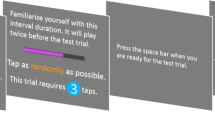Summary
This paper is concerned with the perception of small-scale timing changes in musical sequences. The control and expressive function of these have been studied quite extensively from a production perspective, but not much is known about listeners' ability to detect them. A pilot study and two experiments are reported which investigate the detectability of different amounts of timing change in different sequential positions, different pitch contexts, and against the background of both metronomic and expressive comparisons. The results show that listeners are able to perceive as little as 20 ms lengthening in the context of notes lasting between 100 and 400 ms, and that this threshold appears not to be a function of base duration in this range. Sequential position and pitch structure influence the detectability of timing changes to a limited extent, for which some possible explanations are offered. A case is made for regarding timing in music as both a medium to convey structure and an object in its own right, suggesting that it may be perceptually organized in two different ways — as the consequence of a structural interpretation and as a directly registered quantity.
Similar content being viewed by others
References
Allan L. G., & Kristofferson, A. B. (1974). Psychophysical theories of duration discrimination. Perception & Psychophysics, 16, 26–34.
Clarke, E. F. (1982). Timing in the performance of Erik Satie's “Vexations”. Acta Psychologica, 50, 1–19.
Clarke, E. F. (1985a). Structure and expression in rhythmic performance. In P. Howell, I. Cross, & R. West (Eds.), Musical structure and cognition. London: Academic Press.
Clarke, E. F. (1985b). Some aspects of rhythm and expression in performances of Erik Satie's “Gnossienne no. 5”. Music Perception, 2, 299–328.
Clarke, E. F. (1987a). Levels of structure in the organisation of musical time. Contemporary Music Review, 2, 211–238.
Clarke, E. F. (1987b). Categorical rhythm perception: an ecological perspective. In A. Gabrielsson (Ed.), Action and perception in rhythm and music. Stockholm: Publications issued by the Royal Swedish Academy of Music, no. 55.
Clarke, E. F. (1987c). Perceiving expressive timing in music. Paper delivered at meeting of “Zeit und Musik” group. Bad Homburg, January 1987.
Clarke, E. F., & Baker-Short, C. (1987). The imitation of perceived rubato: a preliminary study. Psychology of Music, 15, 58–75
Cooper, G. W., & Meyer, L. B. (1960). The rhythmic structure of music. Chicago: University of Chicago Press.
Fraisse, P. (1956). Les structures rythmiques. Louvain: Publications Universitaires de Louvain.
Gabrielsson, A. (1987). Once again: the theme from Mozart's piano sonata in A major (K. 331). In A. Gabrielsson (Ed.), Action and perception in rhythm and music. Stockholm: Publications issued by the Royal Swedish Academy of Music, no. 55.
Garner, W. (1974). The processing of information and structure. Potomac: Lawrence Erlbaum Associates.
Jones, M. R. (1987). Perspectives on musical time. In A. Gabrielsson (Ed.), Action and perception in rhythm and music. Stockholm: Publications issued by the Royal Swedish Academy of Music, no. 55.
Lee, D. N. (1980). The optic flow field: the foundation of vision. Philosophical Transactions of the Royal Society of London, Series B, 290, 169–179.
Lerdahl, F., & Jackendoff, R. (1983). A generative theory of tonal music. Cambridge, Mass.: MIT Press.
Longuet-Higgins, H. C. (1976). The perception of melodies. Nature, 263 (5579), 646–653.
McAdams, S., & Bregman, A. S. (1979). Hearing musical streams. Computer Music Journal, 3, 26–43.
Povel, D. J. (1981). Internal representation of simple temporal patterns. Journal of Experimental Psychology: Human Perception and Performance, 7, 3–18.
Schachter, C. (1976). Rhythm and linear analysis: a preliminary study. In F. Salzer & C. Schachter (Eds.), The music forum, Vol. IV, New York: Columbia University Press.
Seashore, C. E. (1938). Psychology of Music. New York: McGraw Hill.
Shaffer, L. H. (1981). Performances of Chopin, Bach and Bartok: studies in motor programming. Cognitive Psychology, 13, 326–376.
Shaffer, L. H. (1982). Rhythm and Timing in Skill. Psychological Review, 89, 109–122.
Shaffer, L. H. (1984). Timing in solo and duet piano performances. Quarterly Journal of Experimental Psychology, 36A, 577–595
Shaffer, L. H., Clarke, E. F., & Todd, N. P. (1985). Metre and rhythm in piano playing. Cognition, 20, 61–77.
Shaffer, L. H., & Todd, N. P. (1987). The interpretive component in musical performance. In A. Gabrielsson (Ed.), Action and perception in rhythm and music. Stockholm: Publications issued by the Royal Swedish Academy of Music, no. 55.
Sloboda, J. A. (1983). The communication of musical metre in piano performance. Quarterly Journal of Experimental Psychology, 35A, 377–396.
Sloboda, J. A. (1985). Expressive skill in two pianists: metrical communication in real and simulated performances. Canadian Journal of Psychology, 39, 273–293.
Sundberg, J., Fryden, L., & Askenfelt, A. (1983). What tells you the player is musical? An analysis-by-synthesis study of music performance. In J. Sundberg (Ed.), Studies of music performance. Stockholm: Publications issued by the Royal Swedish Academy of Music, no. 39.
Todd, N. P. (1985). A model of expressive timing in tonal music. Music Perception, 3, 33–58.
Van Noorden, L. P. A. S. (1975). Temporal coherence in the perception of tone sequences. Eindhoven: Institute for Perception Research.
Vorberg, D., & Hambuch, R. (1978). On the temporal control of rhythmic performance. In J. Requin (Ed.), Attention and Performance, VII. Hillsdale, NJ: Lawrence Erlbaum.
Warren, R. M., Obusek, C. J., Farmer, R. M., & Warren, R. P. (1969). Auditory sequence: confusion of patterns other than speech or music. Science, 164, 586–587.
Wing, A. M., & Kristofferson, A. B. (1973). Response delays and the timing of discrete motor responses. Perception & Psychophysics, 14, 5–12.
Yeston, M. (1976). The stratification of musical rhythm. New Haven: Yale University Press.
Author information
Authors and Affiliations
Rights and permissions
About this article
Cite this article
Clarke, E.F. The perception of expressive timing in music. Psychol Res 51, 2–9 (1989). https://doi.org/10.1007/BF00309269
Received:
Issue Date:
DOI: https://doi.org/10.1007/BF00309269




